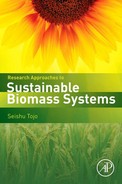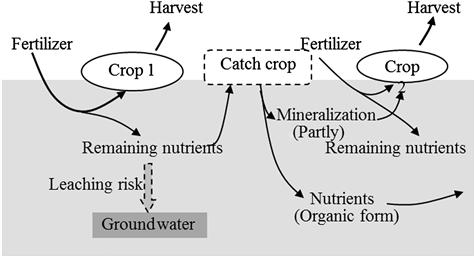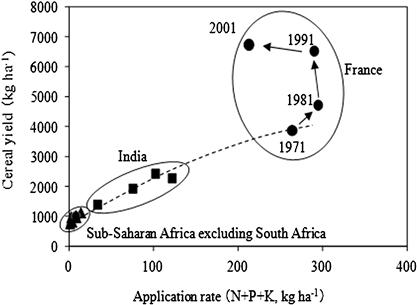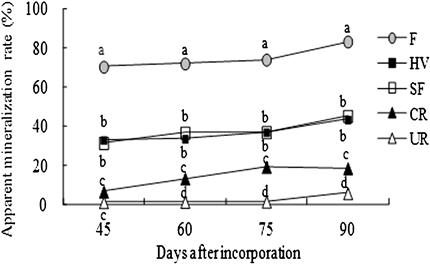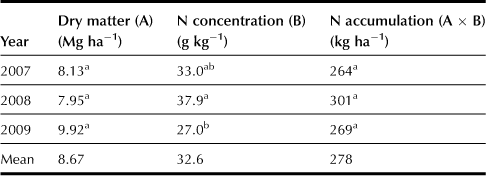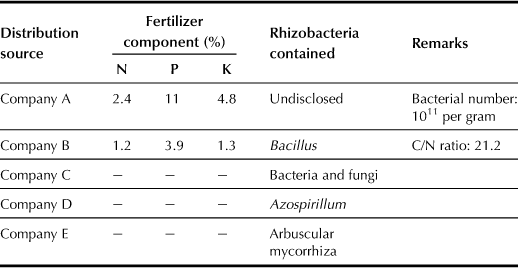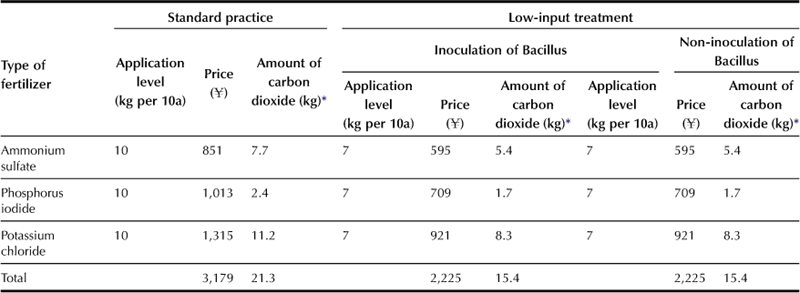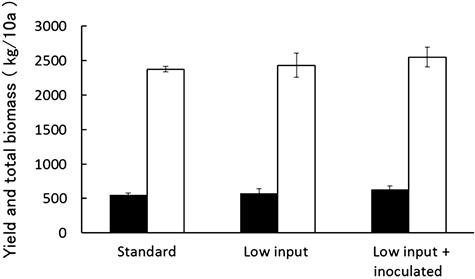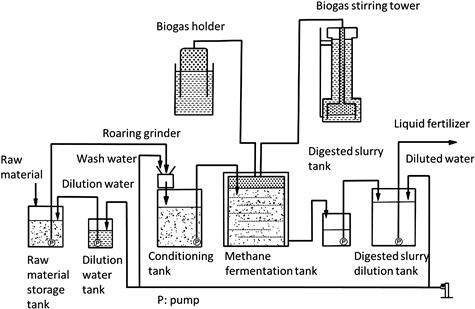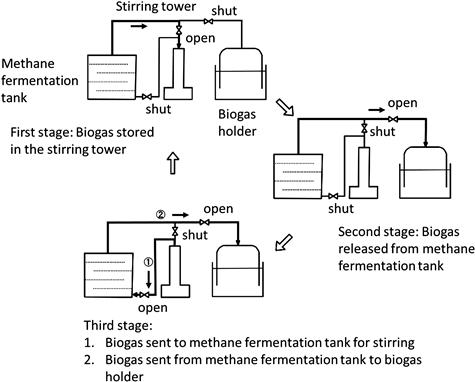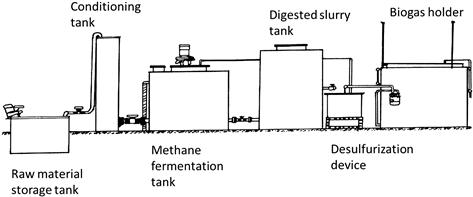Biomass Production and Nutrient Cycling
Shoji Matsumura, Takuya Ban, Shuhei Kanda, Aye Thida Win and Koki Toyota
Abstract
In today’s eco-friendly agriculture, a combination of pursuing high crop yields and maintaining environmental preservation is essential. The problem of water pollution caused by applying superfluous nutrients to improve crop yield may be alleviated by preventing nutrient leaching from farmlands. Utilizing the catch crop is expected to be a promising method for mitigating nutrient leaching. “Biofertilizer” is an organic soil supplement containing microorganisms useful for enhancing plant growth. Several benefits of using biofertilizer have been reported such as developing strong crop roots, and establishing suitable soil environments for crops, among many others. Animal excreta still contain energy materials that can be utilized by methane bacteria to produce methane gas under anaerobic conditions. Bioslurry, the liquid waste after methane fermentation, can then be used as a nutrient source to produce crops. The benefits of using bioslurry on crops have been reported, although ammonia volatilization and denitrification have also been observed to prevent 100% efficiency of nitrogen utilization in the bioslurry application.
Keywords
Low-input sustainable food production system; nutrient cycling system; agricultural water pollution; catch crops; biofertilizer; methane production system; use of digested slurry; denitrification
Chapter Outline
13.1. Crop Production and Cycling of Nutrients
13.1.1. Reasonable Pathway of Nutrient Cycling
13.1.2. Fates of Nutrients Applied to Crop Fields – Nutrient Balance and Water Pollution
13.1.3. Balancing Crop Production and Environmental Conservation – Recycling of Nutrients
13.1.4. A Good Example of Improved Nutrient Balance
13.2.1. What is Biofertilizer?
13.2.2. Use of Biofertilizers in Crop Production
13.2.3. Problems and Future Perspectives of Biofertilizer Use
13.3. Methane Fermentation and Use of Digested Slurry
13.3.2. Methane Fermentation Equipment
13.3.3. Use of Anaerobically Digested Slurry in Japan
13.4. Influence of Fodder Rice Production Using Biogas Slurry for Better Nutrient Cycling on Environmental Quality
13.4.1. Use of Biogas Slurry (BS) for Rice Production
13.4.2. Agriculture and Global Warming Potential
13.4.3. Emission of Methane and Nitrous Oxide in Rice Paddy Fields
13.1 Crop Production and Cycling of Nutrients
Shoji Matsumura
The primary purpose of agriculture is to produce edible plant and animal products. However, some non-dietary plant fibers and wastes from dietary products such as corn stover (or cob) can be utilized as bioenergy. Figure 13.1 shows the cycling of some nutrients in the production system of food products and bioenergy. At present, bioethanol is mainly produced from corn grain and sugar cane molasses, whereas biodiesel fuel (BDF) is obtained from rape and sunflower seeds. The leftover pomace and oil cake after extraction of the liquid portion still contain fibers and energy source materials that can be consumed by ruminants like cows and sheep. Excreta from these ruminants also contain energy source materials that can be fermented by methanogenic bacteria to produce methane gas under anaerobic conditions. The liquid waste after methane fermentation contains many nutrients; it is a valuable nutrient source for growing crops. Such a system, in which both food materials and energy can be sustainably produced, is a more environmentally friendly system than the agricultural systems currently used.
13.1.1 Reasonable Pathway of Nutrient Cycling
In general, crop production is mostly in open fields, with some crops grown in greenhouses. In an open field (Figure 13.2), mineral (chemical) and organic fertilizer (As), compost (manure), dissolved nutrients in rain (Rs), nitrogen fixed by microorganisms (Fxs), and the residue of precedent crops (Rc) are supplied to soil as input, whereas the outputs of nutrients include crop uptake (Us) and the loss through leaching and volatilization (Ls). Similarly, as far as the crop plant is concerned, the nutrient uptake from soil (Us) is the only input, and the outputs are harvested parts of crops for consumption by human (Pc) and domestic animals (Fa), as well as the crop waste residues (Rc). For livestock, the only input is the feed (Fa), and outputs are livestock product (Pa), manure and loss through leaching and volatilization (La).
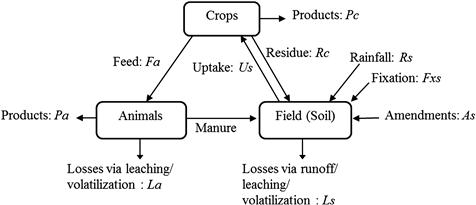
FIGURE 13.2 Pattern diagram of cycling pathways and the balance of nutrients in a typical agricultural system.
Nutrient balance for the whole system: (Pc + Pa) = As + (Fxs + Rs) − (La + Ls).
The mass balance of the whole production system can be expressed by the following equation:
![]()
This equation shows that raising As and Fxs while decreasing (Ls + La) is necessary to increase products (Pc + Pa), because Rs is constant.
However, real-world situations are not as simple as depicted in this equation. The fertilizer use efficiency (FUE) expressed in yield per unit of nutrient gradually decreases based on Mitscherlich’s Law of Diminishing Returns. When fertilization rate As is raised, the crop product Pc will respond to the increase but not proportionally to the increasing rate of As, especially when the rate is outside the optimum range. Increasing (Ls + La) and adverse effects such as crop lodging and degradation of product quality are also expected to such an extent that there must be a reasonable input level, and As cannot be increased in an unlimited manner to give higher yields.
In today’s eco-friendly agriculture, a combination of high yields and adequate environmental preservation is essential. To accomplish these ends, new technologies that will provide sufficient nutrient supply for crop growth while minimizing nutriment loss must be developed. One of the solutions is the utilization of catch crops.
13.1.2 Fates of Nutrients Applied to Crop Fields – Nutrient Balance and Water Pollution
Sequi et al. (2008) showed the circumstances of nitrogen balance in several EU countries for large-scale agricultural activities (Table 13.1). In four countries, i.e. the Netherlands, Belgium, Denmark, and the UK, nitrogen input is superfluous in comparison with the plant uptake based on output of crops from the field, and the nitrogen recovery is less than half of the total nitrogen input that includes animal manure. Especially in the former three countries, nitrogen balance per area exceeds 100 kg N ha−1. What is the fate of the excess nitrogen? A portion is converted by ammonia volatilization and denitrification and then discharged to the atmosphere as nitrogen gas, whereas a considerable amount permeates underground to contaminate groundwater, or is discharged into surface water bodies to cause serious eutrophication. Additionally, the agriculture of these countries is characterized by abundant domestic animals with numbers exceeding the human population, so that more animal manure is generated than the total capacity of all farmland for treating and final disposal of these wastes.
TABLE 13.1
Soil Surface Nitrogen Balance Estimated in Several EU Countries (1995–1997)
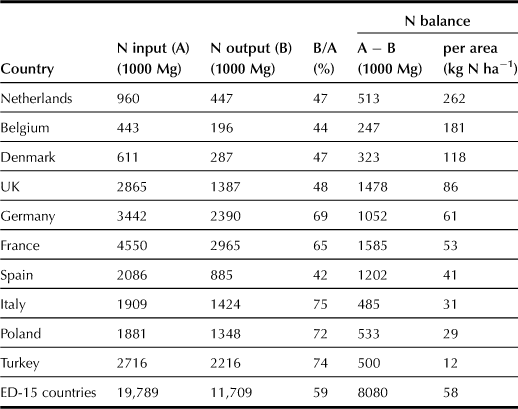
Sources: Sequi et al. (2008); OECD (2001). Environmental Indicatiors for Agriculture: Methods and Results, vol. 3. Several countries have been extracted by the author.
By contrast, the recovery rates of nitrogen input in Germany and France of 69% and 65% respectively are high in comparison with the aforementioned four countries. Because the crop yield level in both Germany and France is high, the production systems are the most progressive when both high crop yield and environmental preservation are considered. Therefore, high yield at a recovery rate of 60–70% is a realistic level that can be achieved by applying present-day technology, and the development of future innovative technologies should aim at recovery rates higher than 60–70%.
The water pollution of major rivers and their apportionment in several EU countries is cited by Nishio (2006) from the European Environment Agency Report (Table 13.2). In this table, the amount of nitrogen discharged from agriculture, domestic wastewater, industrial effluent, among many others, to the environment and the source apportionments are evaluated. Particular source denotes the source that can be observed, including domestic wastewater and industrial effluents. Background source refers to the non-point source of nitrogen flowing out of the natural soil, and the remaining portion is considered to be derived from agricultural sources. Background and agriculture-derived nitrogen levels have not been differentiated by country. Table 13.2 shows that the percentage of agriculture-derived nitrogen in Denmark, Germany, and Poland is high, at 79%, 64%, and 74% respectively. Although not supported by any data included in Table 13.2, the agriculture-derived nitrogen contributes more than 50% of the total nitrogen pollution in the watersheds of the four major rivers in Europe, excepting the Danube. This observation suggests that agriculture is the most significant source of nitrogen pollution in major European rivers. Hence, preventive measures to reduce nitrogen leaching from the farmland need to be implemented in order to alleviate nitrogen pollution of aquatic environments. Similarly, development of such control technologies is urgently needed in Asia because the abundant rainfall is expected to accelerate nitrogen leaching from the farmland, which causes more serious problems than in Europe, where there is a comparatively small amount of rainfall.
TABLE 13.2
Nitrogen Loading to Watershed and the Source Apportionment in Several EU Countries
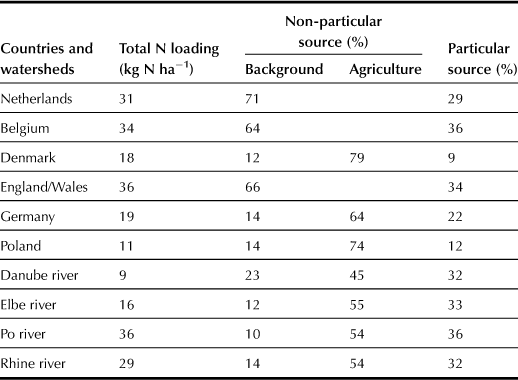
Source: European Environment Agency Report No 7/2005. Cited in Nishio (2006). Several countries have been extracted by the author.
13.1.3 Balancing Crop Production and Environmental Conservation – Recycling of Nutrients
As mentioned in the above sections, high crop yields require appropriate input of nutrients and adequate reduction of losses caused mainly by leaching. Nitrogen and phosphorus are often considered as an environmental issue, whereas other nutrients like potassium, calcium, and magnesium do not cause environmental concerns. This is because, once discharged into surface water bodies, nitrogen and phosphorus lead to serious eutrophication in aquatic systems to contaminate drinking water sources. In addition to water pollution problems, evidence reveals that other positive ions may leach out along with the negative nitrate ions from the soil layer. If the soil originally contains relatively small quantities of positive ions in relation to pedogenic parent materials, as in Japan, leaching of these positive ions should also be a concern from the viewpoint of soil fertility maintenance and economic efficiency. Intensive agriculture is characterized by multiple cropping and heavy fertilization. At present, the interval of two adjacent crops has become shorter than classical crop rotation such as the three-field system, but a period of bare field still exists in Japan. For example, in a typical double-cropping system of vegetables, the first crop (spring sown) is completed by the end of July, and the second crop (autumn sown) begins with fertilization at the end of August. Nutrient uptake by crops is very little for the 2 months when the second crop is still in the seedling stage during September. Therefore, heavy rain during this period will bring about serious leaching of nutrients (Matsumura, 2010). Then, the utilization of catch crops such as sunflower and crotalaria that take up water-soluble nutrients from soil during this period will be effective in reducing leaching loss considerably (Figure 13.3). Askegaarda et al. (2011) have examined the effects of cropping pattern, catch crops, and manure application on nitrate leaching over 12 years in Denmark, where the rainfall is light in April to June and heavy in autumn and winter. They found that plowing in autumn increases nitrate leaching (55 kg-N ha−1) whereas catch crop in autumn minimizes nitrate leaching (20 kg-N ha−1). Thorup-Kristensen et al. (2012) also recognized that growing catch crops during autumn after the main crop as their main source of soil fertility significantly reduces nitrogen leaching loss. Results of field tests conducted in Japan by the authors using sunflower as a catch crop reveal that accumulations of nitrogen, phosphorus, potassium, calcium, and magnesium in sunflower plants 63 days after seeding are 210 kg-N ha−1, 20 kg-P ha−1, 570 kg-K ha−1, 100 kg-Ca ha−1, and 30 kg-Mg ha−1 respectively (Matsumura and Kanazawa, 2011).
However, other observations indicate that catch crops have no such outstanding benefits (Doltra et al., 2011; Nett et al., 2011). Doltra et al. (2011) tested the effects of nitrogen availability on cereal yield, and nitrogen content in the crop for fertilizer application, catch crops, and crop rotation. Their results suggest that only fertilizer application shows positive results, whereas the influence of catch crops is insignificant on cereal yield and nitrogen content.
13.1.4 A Good Example of Improved Nutrient Balance
As mentioned above, Mitscherlich’s Law of Diminishing Returns that relates fertilization level to crop yield is true for cultivation of all scales from a pot experiment to a huge serial field. Maene et al. (2008) have studied the relationship between fertilization level and cereal yield worldwide for 40 years (1961–2001), with the studied agricultural areas divided into three groups, i.e. advanced agricultural technology nations (e.g. France), industrializing (e.g. India), and stagnating countries (e.g. SSA or Sub-Saharan Africa excluding South Africa). Their data illustrate the fertilizer use efficiency (FUE) of these three groups over 40 years (Figure 13.4).
Although FUEs in SSA and India follow Mitscherlich’s Law of Diminishing Returns for 40 years, as seen by the dotted line shown in Figure 13.4, the FUE in France before 1971 fits the dotted line. Since 1971, the FUE in France has exceeded the limitation depicted by this law. For 10 years from 1981 to 1991, cereal yield in France increased about 50% (4500–6500 kg ha−1) without additional application of fertilizer input and, moreover, for the next 10 years from 1991 to 2001, the fertilization level has been drastically reduced without decreasing the yield. This seems to be the result of practicing “integrated nutrient management” (Maene et al., 2008), which should be disseminated worldwide.
Beaudoin et al. (2005) showed the positive result of using catch crops to reduce nitrate leaching in intensive agriculture in France. They examined the effect of good agricultural practice (GAP), which consists of applying accurate amounts of nitrogen, planting catch crops before summer crops, and recycling all crop residues, on nitrate leaching in northern France for 8 years. The results indicate that leaching of nitrate is affected mainly by soil properties, and the nitrate concentration in the percolated water is reduced by half for catch crops. They concluded that GAP is an essential agricultural practice, although not a perfect technique for intensive agriculture. The authors have developed an alternative farming practice, in which a corn production is accompanied by the incorporation of hairy vetch (Vicia villosa Roth.) and manure (see BOX 13.1). In this system, the input and output of nutrients required for corn are well balanced, ensuring compatibility between corn production and soil fertility maintenance without the need for synthetic amendment.
13.2 Biofertilizer
Takuya Ban
13.2.1 What is Biofertilizer?
It is not clear when humans began to use fertilizers for crop production. However, people in the distant past were aware of the advantages of enhancing crop production by applying human and animal wastes, plant ash, carcasses, and many other forms of organic matter. Some of these natural organic fertilizers are still used in today’s agriculture. John Lawes conducted experiments in 1840 with the objective of using artificial chemicals, i.e. bones treated with sulfuric acid, as a fertilizer (Perry, 1992). He discovered that substances made from non-fertilizer materials have similar fertilizer values as natural bones. These artificial substances are capable of providing a readily available source of phosphorus for crop growth. The Haber–Bosch process, which is a chemical process to convert atmospheric N2 to NH3, was discovered in 1913 and provides an unlimited supply of nitrogen fertilizer for crop production (Galloway and Cowling, 2002). After this process was discovered, crop productivity and the global human population began to increase rapidly. However, excessive use of chemical fertilizer on crops is realized nowadays to cause serious environmental problems, including water pollution, salt accumulation in crop fields, and emission of excessive greenhouse gases.
Research on building effective cyclic food production systems with low nutrient and energy inputs has been undertaken globally in recent years. Biofertilizer plays a very important role in making such food production systems practical; it is defined as preparations containing microbial living or latent cells that enhance plant growth via the nature of their interactions in the rhizosphere (Mishra and Dadhich, 2010). In Japan, fertilizers that originate from biomass are defined as biofertilizers in a broad sense. Nitrogen-fixing bacteria, some fungi that form mycorrhizae on host plants, and phosphate solubilizers contribute to the natural production of biofertilizer (Ohyama, 2006).
In this chapter, an overview of biofertilizer usage in crop production is provided. The findings concerning (1) the development of crop production systems with applications of green manure and compost, and (2) application of solid-phase methane fermentation for crop production system are discussed in Sections 13.1 and 13.3.
The area of agricultural field where biofertilizers are actually applied for crop production has increased at the forefront of East Asian economies. In Japan, biofertilizers have also been commercialized. The application of biofertilizers has been extended to growing various agricultural products such as flowers, vegetable, fruit, field crops, and feed crops. The beneficial effects of biofertilizers include: (1) accelerated organic compound degradation in the soil; (2) improved aeration properties of the soil; (3) promoted root system development of the crop; (4) propagation of useful microbes for plant development in the soil; and (5) inhibited propagation of harmful microbes (Table 13.5). If more farmers use biofertilizers for crop production, the use of chemical fertilizers will decline and, as a result, the emission of greenhouse gases during the production and application of chemical fertilizers will be significantly alleviated.
13.2.2 Use of Biofertilizers in Crop Production
The availability of biofertilizers in crop production is obvious. However, there has been little information published in the literature concerning the effects of biofertilizer use during crop production on environmental quality and economic development. In this chapter, the beneficial effects of biofertilizers during crop production on crop yields, greenhouse gas emissions, and fertilizer costs are discussed.
Case 1: Soybean Production with Manure Compost
One of the aims of the Field Science Center, Tokyo University of Agriculture and Technology, is to develop new cultural techniques based on recent scientific advances. To examine the effects of organic manure usage on the productivities of main crops and cultivation environments, a selected field was fertilized with organic manure for more than 20 years. The total harvested area of soybean in 2011 was 1.45 ha, with a total yield of 1.85 Mg (Table 13.6). Chemical fertilizers and organic manure were also used side by side for soybean production. The total monetary values of fertilizers applied in 2011 were 15,139 yen per 10a for chemical fertilizers and 16,828 yen per 10a for organic manure. Based on the price of these fertilizers, the level of carbon dioxide emissions in manufacturing these fertilizers was estimated (NIAES, 2003) to be 71.9 kg-CO2 for chemical fertilizer, which is higher than the 40.4 kg-CO2 for organic manure. Little difference in crop yield was observed between the chemical fertilizer and organic manure applications. These results indicate that, for cultivation of soybean, organic manure emits less greenhouse gas than chemical fertilizers.
Case 2: Forage Rice ‘Leafstar’ Production with Nitrogen-Fixing Bacteria
Torii (2012) investigated the environmental factors that affect the inoculation effects of Bacillus pumilus TUAT-1 on the growth of the forage rice ‘Leafstar’. He concluded that inoculating Bacillus pumilus TUAT-1 into ‘Leafstar’ improves the water and nutrition absorption capacity of the plant root system and promotes the absorption of nitrogen from soils during the early growth period of the plant (Table 13.7). The increased nitrogen absorption promotes tillering, increases the number of ears, and holds the photosynthesis activity at the late growth period of the plant so that the crop yield is boosted. There are no differences among the yields for the control, low-input, and low-input with inoculation samples (Figure 13.6). The total monetary values of chemical fertilizers applied in control, low-input, and low-input with inoculation samples were 3,179, 2,225, and 2,225 yen per 10a respectively. Based on the cost of fertilizer, the amount of carbon dioxide emission in the manufacture of the fertilizer was calculated (NIAES, 2003) to be 21.3 kg-CO2 for the standard practice, higher than the 15.4 kg-CO2 for low-input treatment. These results indicate that cultivation of ‘Leafstar’ inoculated with nitrogen-fixing bacteria emits less greenhouse gas than standard practice.
Case 3: Corn Production with Green Manure
Sharifi et al. (2011) examined the effect of crop rotation with hairy vetch as a green manure on corn production. They showed that the incorporation of hairy vetch residue or placement of hairy vetch residue on the soil surface increases above-ground biomass, grain yield, and nitrogen uptake of the corn plants. From these results, they concluded that incorporation or surface placement of hairy vetch residue is effective in supplying nitrogen to corn plants. As shown by Cases 1 and 2, the use of green manure reduces the total amount of chemical fertilizers and carbon dioxide emissions without affecting crop production. They also noted that the main crop is capable of utilizing the nitrogen released from the green hairy vetch manure, but an appropriate supply of minerals is needed to ensure successful growth of hairy vetch to sustain corn production over a long period of time.
13.2.3 Problems and Future Perspectives of Biofertilizer Use
Numerous publications confirm the effectiveness of biofertilizer use on plant growth under laboratory conditions; however, there are many problems in applying biofertilizers to practical fields to grow crops. Plant growth promotes rhizobacteria that accelerate the development of plant root systems, but the inoculation effect may be masked depending on the cultural environment. Many farm fields use chemical fertilizers that are easily absorbed and used by crop plants. Hence, the plants do not need to depend on nutrients derived from the coexisting rhizobacteria. For example, when grown under horticultural conditions with rich nutrients from chemical fertilizer applied by the grower, blueberry plants have lower colonization rates of ericoid mycorrhiza than those growing in the wild (Yang et al., 2002). The maximum effect of biofertilizers needs to be investigated by analyzing the functions of rhizobacteria in order to study how environmental factors affect their inoculation.
When using compost manures, one has to address the optimization of manure distribution channels. In Japan in particular, livestock are not always grazed in the neighborhood of the crop field where the manure is to be applied. Hence, the transportation of manure from the source to the application point will also lead to additional emissions of carbon dioxide.
13.3 Methane Fermentation and Use of Digested Slurry
Shuhei Kanda
13.3.1 Methane Fermentation
a General Outline
Increasing consumption of fossil fuels, e.g. natural gas, petroleum and coal, leads to rapidly increasing emissions of greenhouse gases such as carbon dioxide (CO2) that cause global warming problems. Reducing the use of fossil fuels by promoting the use of renewable energy will alleviate the problems brought about by consuming fossil fuels.
Nowadays, European countries like Germany and Denmark attempt to utilize biomass resources in addition to promoting the production of clean energy from biomass. Small-scale methane fermentation that was popularly used in the past has been revived to produce biofuel, especially in some Asian countries like China and Vietnam.
In Japan the utilization of renewable energy from disposal of biomass, including animal wastes, unused biomass, and inedible crops, is stipulated by the Ministry of Agriculture Forestry and Fisheries (2003) in “Biomass Japan Strategy”. Recently, the implementation of methane production techniques using animal wastes has brought remarkable achievements because of substantially increasing production of both heat and electricity from biogas, as well as use of by-product of biogas for fertilizer.
b Current Situation of Methane Fermentation in Europe
Concerning the welfare of future generations, Germany has decided to refrain from the use of nuclear power to avoid the risks of nuclear pollution due to accidents and inappropriate treatment and disposal of radioactive waste.
In Sweden, renewable energy like biogas and bioethanol is produced by using various types of biomass resources. Large-scale methane fermentation plants now operate in 10 areas. Biogas plants using animal wastes as raw material are managed by local governments producing methane gas and digested slurry to benefit rural farms.
In Denmark, large-scale biogas plants are managed by cooperating communities. Profits from the production of methane gas were insignificant when the techniques were still at the developmental stage. Because most costs were defrayed by farmers, agricultural groups formed the “Auction Program” in 1987 for rebuilding biogas plant enterprises (Research Association of Hokkaido Biogas, 2002), with 30–40% of the initial capital cost paid by central government. Wastes from food industries and household kitchens are now also added as raw materials to produce biogas. Renewable energy such as biogas and wind power, among others, supplies almost 100% of energy requirements in Denmark.
Therefore, these nations support the development of natural energies like solar, wind and geothermal, and many others by advancing current technologies. However, many problems associated with the distribution of renewable energy exist. For example, rural regions may be more suitable than urban regions to produce renewable energy but the demand there is much less. How to transport the excess energy from rural producers to urban consumers cost-effectively needs to be studied.
c Current Situation of Methane Fermentation in Japan
(i) General Outline
In Japan the first group of methane fermentation plants was put into operation in 2000. Some of these plants have been closed for economic reasons.
The infamous earthquake in the Tohoku district that caused the accident at the Fukusima First Nuclear Power Station has motivated the nation to emphasize the development of renewable energy sources, including solar, wind, geothermal, and biogas, as a priority to meet future energy demands. Since 2011, the Japanese government has subsidized the construction of commercialized biogas plants and products as well.
(ii) Present Standing of Methane Fermentation Plants
The present situation regarding methane fermentation plants in Japan is shown in Table 13.8. More than 60 plants, including experimental pilot plants, have been installed; 40% of these plants were financially supported by local governments and 65% were constructed on animal husbandry farms.
TABLE 13.8
Number of Biogas Plants (Methane Fermentation) in Japan (2011)

Sources: Dairy Journal special edition (2002). Animal wastes: Effective usage of biogas systems. Dairy Journal special edition (2006). Social and economic evaluations of dairy biogas systems.
In Hokkaido in particular, 33 plants have been built in order to effectively use the anaerobically digested slurry (ADS) in addition to preventing bad odors. Many mega dairy farms in Hokkaido experienced the problem of bad odor when making slurry manure before they adopted anaerobic equipment. Using methane fermentation equipment has helped dairy farms to solve these problems, as well as producing clean methane gas energy and ADS as liquid fertilizer.
13.3.2 Methane Fermentation Equipment
a Mechanisms of Methane Fermentation
In a general model of the two-stage methane fermentation process, raw materials are decomposed biologically into organic acids in the first-stage acid-producing tank as the first step. The acids are then sent to the second-stage fermentation tank where they are fermented anaerobically into methane gas (Eckenfelder, 1966). Two separate tank reactors are needed in this two-stage methane fermentation process for smooth and continuous operation (Ghosh, 1987).
b Single-Tank System for Methane Fermentation
Using a one-tank system will save the initial cost and make the operation more cost-effective. Two types of single-tank system have been developed by Mori group & Taguchi (M&T) (Kanda, 2005) and P-Works (2003) in Japan.
(i) M&T Methane Fermentation Plant
The M&T methane fermentation plant is shown schematically in Figure 13.7, with the dimensions and capacities of the plant listed in Table 13.9.
TABLE 13.9
General Specification of M&T Methane Fermentation Experimental Plant∗
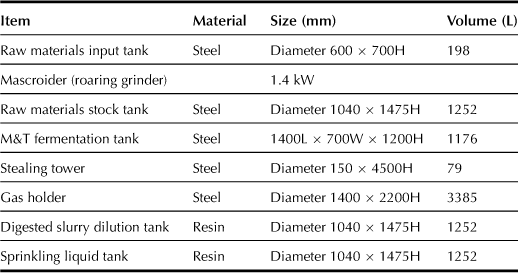
∗Designed by Mr Akira Taguchi (Science Information System and Co., Mori group).
The major features of the fermentation plant are as follows:
• Fixation of methanogenic bacteria. The bacteria stall, which has a brush made of polypropylene material, is capable of reproducing anaerobic bacteria and enhances their retention abilities.
• Horizontal flow control boards. These can improve the symbiotic environment of anaerobic bacteria, and maintain the slow flow that makes effective fermentation possible.
• Automatic gas lifted stirring system (Figure 13.8). Biogas in the methane fermentation tank is stored temporarily in a holding tower. When the gas pressure rises to a certain high level, the control valve opens automatically, allowing the biogas to flow toward the methane fermentation tank, and the rising biogas stirs the fermentation slurry in the tank. This method allows the fermentation slurry to be stirred efficiently and cost-effectively.
(ii) P-Works Methane Fermentation Plant
An outline of the methane fermentation experimental plant developed by P-Works is shown in Tables 13.9 and 13.10 and Figure 13.9. The plant consists of five directly connected units: (1) raw material storage tank, (2) conditioning tank, (3) methane fermentation tank, (4) digested slurry tank, and (5) desulfurization device and biogas holder (Table 13.11). The second, third, and fourth tanks are interconnected with 100-mm pipes and control valves; a PVC pipe is used to connect the head of the methane fermentation tank to the biogas holder through a desulfurization device.
TABLE 13.10
Features of Methane Fermentation Experimental Plant
| Item | Treatment |
| Input | Cattle wastes 20 kg + water 20 L |
| Biogas production | 0.5 m3 day−1 |
| Fermentation condition | Middle temperature 35–40°C |
TABLE 13.11
Retention Time of Each Tank Process
| Item | Volume (m3) | Retention (days) |
| Raw material storage tank | 0.50 | 12 |
| Conditioning tank | 0.13 | 3 |
| Methane fermentation tank | 2.00 | 50 |
| Digested slurry tank | 1.40 | 35 |
| Biogas holder | 2.83 | 3.6 |
| Desulfurization device | 0.18 | – |
The methane fermentation plant is easy to operate because of the simple design. This plant needs an additional heating unit to maintain the tank temperature in the optimum mesophilic range to keep the methane fermentation process operating normally during winter months, when the ambient temperature decreases below the optimum temperature range.
13.3.3 Use of Anaerobically Digested Slurry in Japan
In several cases, after the anaerobically digested slurry (ADS) is treated, the supernatant liquid is decanted to be discharged into a surface water body, and the odorless treated ADS may be used as a fast-acting fertilizer by neighborhood farmers to grow crops.
Mega dairy farms (200–300 head) in Hokkaido used to make slurry manure, but the bad odor adversely affected the environmental quality of the surrounding regions. This problem can be solved by using methane fermentation plants that also have the benefit of producing methane gas as renewable energy. About 40 dairy farms in Hokkaido had built methane fermentation plants to produce odorless ADS as liquid fertilizer by 2006. The digested slurry is injected into the surface soil layer of the farmland with a slurry injector, as shown in Figure 13.10. Farmers are subsidized by government for up to 75% of the initial costs for building their methane fermentation plants. The use of ADS as fertilizer in paddy fields in Japan needs to be evaluated in future studies.

FIGURE 13.10 Slurry injectors. (Source: Watanabe, 2002.)
13.4 Influence of Fodder Rice Production Using Biogas Slurry for Better Nutrient Cycling on Environmental Quality
Aye Thida Win and Koki Toyota
13.4.1 Use of Biogas Slurry (BS) for Rice Production
Biogas plants convert many types of organic wastes, such as agricultural waste, animal waste, kitchen waste, sewage sludge, organic sludge, residues, etc., into biogas and slurry fertilizer known as biogas slurry (BS) that is rich in valuable nutrients for crop production. On the other hand, direct discharge of this slurry to surface water bodies will cause serious eutrophication of lakes and rivers. Thus, recycling these wastes is very important to avoid polluting the environment while maintaining sustainable farming systems. Many studies have revealed that BS application shows no adverse effects on rice yield but increases biomass production. For example, 450–600 kg-N ha−1 of biomass production was reported by Sunaga et al. (2009). Lu et al. (2012) also observed that applications of more BS lead to higher rice grain yields when fields were treated with biogas slurry at 270, 405, and 540 kg-N ha−1. Because biogas slurry is available in large quantities almost anywhere for field application, its use will significantly reduce the need for commercial chemical fertilizers and the associated costs. Oki town in Fukuoka prefecture is the most advanced municipality in terms of BS recycling in Japan.
Unlike chemical fertilizers that are almost homogeneous in composition, BS contains large amounts of carbon and undesirable elements. Thus, there are concerns about several negative environmental affects caused by BS applications. One of the major characteristics of BS is its high pH (pH 8–9) that enhances NH3 volatilization under high pH conditions. Loss of ammonia due to volatilization accounts for 13.3% of the total nitrogen contained in the soil applied with BS; this amount is much higher than the value of 1.9% for fields with CF (chemical fertilizer) application (Win et al., 2009). This high loss of NH3 due to volatilization with BS application can be mitigated by acidifying the sludge with acid, e.g. wood vinegar or sulfuric acid, or by keeping deeper floodwater in the paddy field to decrease the NH4+ concentration in the floodwater. Animal feeds are often enriched with metallic elements such as Zn and Cu among many others, as well as higher levels of heavy metals. Accumulation of these heavy metals in the rice crop becomes a major concern about rice production fertilized with BS, although application of BS even at a rate of 1080 kg-N ha−1 has been shown not to increase the levels of heavy metals (Cu, Hg, Cd, and Pb) in the soil (Lu et al., 2012). The use of BS as fertilizer for rice may not cause heavy metal contamination in the short term; the consequences of long-term BS applications should be carefully evaluated in future studies.
13.4.2 Agriculture and Global Warming Potential
The global agricultural field constitutes about 35% of total land area (Betts et al., 2007). Because of its scale and intensity, farming land emits a significant quantity of greenhouse gases (GHGs) into the atmosphere. In agriculture, CO2 is released largely from microbial decomposition of soil organic matter, whereas methane is produced by microbial decomposition of organic materials in soil under anoxic conditions, especially in flooded rice fields. Nitrous oxide is generated by the microbial transformation of nitrogen in soil via nitrification and denitrification processes.
There are a variety of management practices for mitigating GHG emissions in agricultural fields. The most prominent options include those that improve crop and land management (e.g. improved agronomic practices, nutrient use, tillage, and residue management), restore wetland that has been drained for crop production and degraded lands, improve water and rice management, change the land use pattern such as the conversion of cropland to grassland, and improve livestock and manure management, among many other practices (UNFCCC, 2010). According to the Intergovernmental Panel on Climate Change (IPCC) (1996), agriculture-related CH4 emissions can be reduced by 15–56%, mainly through the improved nutrition of ruminant domestic animals and better management of paddy rice, which may also reduce N2O emissions by 9–26%.
13.4.3 Emission of Methane and Nitrous Oxide in Rice Paddy Fields
Methane emission from rice fields is controlled by several factors such as carbon source, temperature, soil moisture regime, soil redox potential, time and duration of drainage, soil type, rice variety, fertilizer, and cultural practices as well as climate (Conrad, 2002). Methane production is negatively correlated with soil redox potential and positively correlated with soil temperature, soil carbon content, and rice growth (Neue, 1993). The water management system is one of the most important factors affecting CH4 emissions. Easily degradable crop residues including fallow weeds and soil organic matter are the major sources for initial CH4 production during the early stage of crop growth. During the later stages of growing rice, methane production is influenced more by root exudates, decaying roots, and aquatic biomass (Sass et al., 1991).
Methane emissions in paddy fields can be reduced by practicing various methods such as draining the field once or several times during the rice growing season to keep root exudation low, keeping the soil as dry as possible in the rice off-season, adjusting the timing of organic residue additions such as by incorporating organic materials during the dry period rather than in the flooded periods, or by composting the residues before incorporation. The application of organic manure like BS can enhance methane emission. Sasada et al. (2010) found that the global warming potential (GWP) based on the CH4 and N2O emissions from a forage rice soil applied with BS is 860 ± 310 g-CO2 m−2 (exclusively contributed by CH4 emission), which is more than twice the emission (400 ± 44 g-CO2 m−2) from fields with CF application. However, changing the type of BS applied, such as from cow manure to pig manure, leads to a 23% reduction of GWP (Figure 13.11). Although BS application can enhance CH4 emission in rice soil, it may improve soil carbon contents, and the benefit will compensate for the disadvantage of the resulting enhanced CH4 emission (Win et al., 2010).
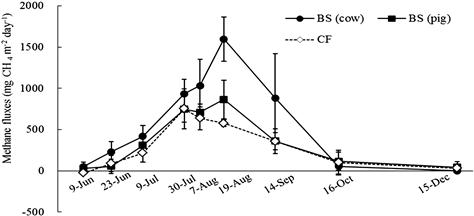
FIGURE 13.11 Effect of chemical fertilizer (CF) or different types of biogas slurry (BS) on CH4 emissions.
Mean value ± standard deviation (n = 3). (Redrawn from Sasada et al., 2010.)
In rice fields, N2O flux is controlled mostly by nitrogen fertilization and also by the type of fertilizers, soil water regime, and soil texture (Hua et al., 1997). In Japan, Minami (1987) found that N2O emission from paddy fields ranges from 0.33% to 0.55% of nitrogen fertilization. However, N2O emission from flooded rice fields is usually low and only becomes significant when the field becomes dry after the final drainage for harvest.
13.4.4 Carbon Sequestration in Rice Soil
Carbon sequestration in soil is an option for mitigating the global warming potential. The IPCC (1996) estimated that 400–800 Mt-C y−1, equivalent to about 1400–2900 Mt-CO2 y−1, can be sequestered globally in agricultural soil. Various management techniques can be used to enhance carbon sequestration in soils (Janzen et al., 1999). Pan et al. (2003) reported that significant application potential for soil carbon sequestration has been found in rice paddies because the long period of flooding causes the soil to accumulate organic carbon even after the above-ground biomass has been completely removed.
References
1. Adachi M, Tsuji A, Matsumura S. Nutrient balance in corn production by combined application of hairy vetch and manure. Abstract of the Annual Meeting of the Japanese Society of Soil Science and Plant Nutrition. 2011;57:142 [in Japanese].
2. Askegaarda M, Olesena JE, Rasmussenb IA, Kristensenc K. Nitrate leaching from organic arable crop rotations is mostly determined by autumn field management. Agriculture, Ecosystems and Environment. 2011;142:149–160.
3. Beaudoin N, Saad JK, Van Laethem C, Machet JM, Maucorps J, Mary B. Nitrate leaching in intensive agriculture in Northern France: Effect of farming practices, soils and crop rotations. Agriculture, Ecosystems and Environment. 2005;111:292–310.
4. Betts RA, Falloon P, Goldewijk KK, Ramankutty N. Biogeophysical effects of land use on climate: Model simulations of radiative forcing and large-scale temperature change. Agricultural and Forest Meteorology. 2007;142:216–233.
5. Conrad R. Control of microbial methane production in wetland rice fields. Nutrient Cycling in Agroecosystems. 2002;64:59–69.
6. Doltra J, Lægdsmand M, Olesen JE. Cereal yield and quality as affected by nitrogen availability in organic and conventional arable crop rotations: A combined modeling and experimental approach. European Journal of Agronomy. 2011;34:83–95.
7. Eckenfelder Jr WW. Industrial water pollution control. McGraw-Hill 1966; Interpreted by Ichikawa, K. & Maeda, Y. (1970). Treatments of industrial water pollution. Tokyo: Kouseikaku.
8. Galloway JN, Cowling EB. Reactive nitrogen and the world: 200 years of change. Journal of the Human Environment. 2002;31:64–71.
9. Ghosh S. Improved sludge gasification by two-phase anaerobic digestion. Journal of Environmental Engineering. 1987;113:1265–1284.
10. Hua X, Xing GX, Cai ZC, Tsuruta H. Nitrous oxide emissions from three rice paddy fields in China. Nutrient Cycling in Agroecosystems. 1997;49:23–28.
11. Ichikawa O, Nakahara J, Hoshiba S. Sociological and biological assessment of dairy biogas system. Rakuno Gakuen University extension center 2006; pp. 181.
12. IPCC. SAR, climate change 1995: The science of climate change Contribution of Working Group I to the Second Assessment Report of the Intergovernmental Panel on Climate Change (IPCC). Cambridge: Cambridge University Press; 1996.
13. Janzen HH, Desjardins RL, Asselin JMR, Grace B. The health of our air: Towards sustainable agriculture in Canada. Publication 1981/E Ottawa, ON: Agriculture and Agri-Food Canada; 1999.
14. Kanda S. Animal waste treatment and utilization by using methane fermented device. Symposium of Kanto district of Japanese farm work research 1988;13–22.
15. Kanda S. Utilization of cattle waste by using methane fermented device. Farm work research, special edition 2005; pp. 87–88.
16. Lu J, Jiang L, Chen D, et al. Decontamination of anaerobically digested slurry in a paddy field ecosystem in Jiaxing region of China. Agriculture, Ecosystems and Environment. 2012;146:13–22.
17. Maene LM, Sukalac KE, Heffer P. Global food production and plant nutrient demand: Present status and future prospects. In: Aulakh MS, Grant CA, eds. Integrated nutrient management for sustainable crop production. New York: CRC Press; 2008;1–28.
18. Matsumura S. Field estimation of nitrogen balance. In: Ohyama T, Sueyoshi K, eds. Nitrogen assimilation in plants. Kerala, India: Research Signpost; 2010;33–49.
19. Matsumura S, Kanazawa M. Recycling of soil-remaining nutrients by using cover crops. Abstract of the Annual Meeting of the Japanese Society of Soil Science and Plant Nutrition. 2011;57:142.
20. Mishra BK, Dadhich SK. Methodology of nitrogen biofertilizer production. Journal of Advances in Developmental Research. 2010;1:3–6.
21. Minami K. Emission of nitrous oxide from agro-ecosystem. JARQ, Japan Agricultural Research Quarterly. 1987;21:21–27.
22. National Institute for Agro-Environmental Sciences (NIAES). Manual for life cycle assessment of agricultural practices in Japan. 2003; (pp. 1–51). NIAES.
23. Nett L, Feller C, George E, Fink M. Effect of winter catch crops on nitrogen surplus in intensive vegetable crop rotations. Nutrient Cycling in Agroecosystems. 2011;91:327–337.
24. Neue HU. Methane emission from rice fields: Wetland rice fields may make a major contribution to global warming. BioScience. 1993;43:466–473.
25. Nishio M. Reports of environmental conservation typed agriculture, No 48: Agriculture is the primary cause for water pollution in the EU. 2006; In: <http://lib.ruralnet.or.jp/libnews/nishio/nishio048.htm>; 2006.
26. Ohyama T. Introduction. In: Biofertilizer manual. Japan Atomic Industrial Forum 2006;1–2.
27. Pan GX, Li LQ, Wu LS, Zh XH. Storage and sequestration potential of topsoil organic carbon in China’s paddy soils. Global Change Biology. 2003;10:79–92.
28. Perry WE. The utilization of by-products and waste products in the production of commercial fertilizers. Fertilizer Research. 1992;32:111–114.
29. Provorov NA, Tikhonovich IA. Genetic resources for improving nitrogen fixation in legume–rhizobia symbiosis. Genetic Resources and Crop Evolution. 2003;50:89–99.
30. Research Association of Hokkaido Biogas. Animal wastes effective usage of biogas system. Dairy Journal special edition Rakuno Gakuen University extension center 2002.
31. Sasada Y, Win KT, Nonaka R, et al. Environmental impact in a whole crop rice cultivation fertilized with anaerobically digested cattle or pig slurry. Biology and Fertility of Soils. 2010;47:948–956.
32. Sass RL, Fisher FM, Lewis ST, Jund MF, Turner FT. Methane emission from rice fields as influenced by solar radiation, temperature, and straw incorporation. Global Biogeochemical Cycles. 1991;5:335–350.
33. Sequi P, Johonston AE, Francaviglia JR, Farina R. Integrated nutrient management: The European experience. In: Aulakh MS, Grant CA, eds. Integrated nutrient management for sustainable crop production. New York: CRC Press; 2008;221.
34. Sharifi MZ, Matsumura S, Hirasawa T, Komatsuzaki M. Apparent nitrogen mineralization rates of several green manures incorporated in soil and the application effects on growth of komatsuna plants. Japanese Journal of Farm Work Research. 2009;44(3):163–172.
35. Sharifi MZ, Matsumura S, Ito T, Hirasawa T, Komatsuzaki M. Improvement of nitrogen balance by rotating corn and hairy vetch. Japanese Journal of Farm Work Research. 2011;46:167–177.
36. Sunaga K, Yoshimura N, Hong H, et al. Impacts of heavy application of anaerobically digested slurry to whole crop rice cultivation in paddy environment on water, air and soil qualities. Japanese Journal of Soil Science and Plant Nutrition. 2009;80:596–605 [in Japanese with English summary].
37. Thorup-Kristensen K, Dresbøll DB, Kristensen HL. Crop yield, root growth, and nutrient dynamics in a conventional and three organic cropping systems with different levels of external inputs and N re-cycling through fertility building crops. European Journal of Agronomy. 2012;37:66–82.
38. Torii A. Analysis of field factors resulting fructuations of yield and nutritional uptakes of forage rice Leaf Star with inoculation of an endophytic nitrogen fixing bacteria TUAT1 Master thesis of Graduate school of agriculture. Tokyo University of Agriculture and Technology 2012.
39. UNFCCC. United Nations Framework Convention on Climate Change, United Nations Climate Change Conference Cancun – COP 16/CMP 6, Land use, land-use change and forestry. 2010.
40. Watanabe. Effective use of animal wastes by biogas system – usage techniques of methane digested liquids Dairy Journal special edition 2002. 2002.
41. Win KT, Toyota K, Motobayashi T, Hosomi M. Suppression of ammonia volatilization from a paddy soil fertilized with anaerobically digested cattle slurry by wood vinegar application and floodwater management. Soil Science and Plant Nutrition. 2009;55:190–202.
42. Win KT, Nonaka R, Toyota K, Motobayashi T, Hosomi M. Effects of option mitigation ammonia volatilization on CH4 and N2O emissions from a paddy field fertilized with anaerobically digested cattle slurry. Biology and Fertility of Soils. 2010;46:589–595.
43. Yang WQ, Goulart BL, Demchak K, Yadong L. Interactive effects of mycorrhizal inoculation and organic soil amendments on nitrogen acquisition and growth of highbush blueberry. Journal of the American Society for Horticultural Science. 2002;127:742–748.
